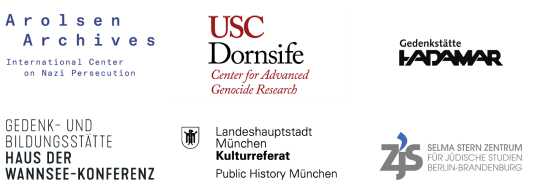Annotations
Hattingen
04/28/1942
Hermann Ostwald and Julius Friedhoff carry a luggage crate in the courtyard of the former rifle factory. They look directly at the photographer. Another unidentified person can be seen in the background.
Annotations
People
1
Keywords
2
Historical context
Deportation von Hattingen nach Zamość im April 1942
In April 1942, 15 people from Hattingen persecuted as Jews were deported to Zamość. In the summer of 1941 already, they had been forced to move into ramshackle apartments in an old rifle factory near the River Ruhr outside the town center. From there, they were forced to march to Hattingen train station on April 28, 1942. They were taken by train, presumably via Hagen, to Dortmund Süd. There they were interned in the gymnasium of the "Eintracht" sports club on Rheinlanddamm, which had been turned into an assembly camp. A total of 791 people were deported from Dortmund on April 30, 1942. A few weeks after their arrival in Zamość on May 3, the people underwent a "selection" for forced labor in the ghetto on May 24. Many people were murdered in Belzec or Sobibor. The Zamość ghetto was dissolved in October 1942. No one is known to have survived the Dortmund deportation.
About the image series
A series of 13 photographs titled “Abschiebung der Juden in das Generalgouvernement” (deportation of Jews to the General Government) has survived from Hattingen. The pictures are available as original prints (photographic paper 12 x 9 cm) mounted on cardboard in Stadtarchiv Hattingen (town archives Hattingen). Archivist Thomas Weiß made handwritten notes on the pictures about the persons he was able to identify.
The pictures show the departure of the deportees and the transport of their luggage in the courtyard of the rifle factory. They also document the deportees walking to the train station and the train ready for departure. The people left behind in the Hattingen rifle factory, some of whom are shown in the photos, were deported to Theresienstadt in July 1942.
Photographer
Unknown, Unknown
The name of the person who took the photos is not known. One possibility is that the pictures were taken by Hans Holländer, the cultural officer of the town of Hattingen. A journalist by profession, Holländer had already documented local war damage and the subsequent reconstruction of the town on behalf of the town’s administration. Considering the selection and the composition of the pictures, it can be assumed that the photographic documentation of the deportation was commissioned by the town’s administration and executed by Holländer as well.
Provenance
The photos were probably part of the town’s documentation of the deportation because they show the procedure and the orderly implementation of the deportation from the point of view of the local authorities. The fact that they have been preserved as original prints in Stadtarchiv Hattingen substantiates this interpretation. It is not known, though, when exactly and by whom the pictures were handed over to Stadtarchiv Hattingen. They have been part of the archives’ collection since the 1960s at the latest.
Call number at source archive
ohne Signatur
Title at source archive
„Abschiebung der Juden in das Generalgouvernement“
Acknowledgements
The description of the picture series from Hattingen is based on the longstanding research work conducted by Thomas Weiß, the archivist of Stadtarchiv Hattingen. We would like to express our sincere thanks to Mr. Weiß for supporting the project and providing extensive information and materials.
Text and research by Henning Borggräfe und Malte Grünkorn.
Kooperationsverbund #LastSeen. Bilder der NS-Deportationen Dr. Alina Bothe Projektleiterin
c/o Selma Stern Zentrum für Jüdische Studien Berlin-Brandenburg
Freie Universität Berlin
Habelschwerdter Allee 34A
14195 Berlin
lastseen@zedat.fu-berlin.de
Ein Kooperationsprojekt von

Gefördert durch

Datenschutz | Impressum